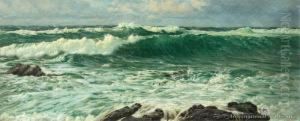George R. Sherriff Paintings
George Roger Sherriff, born in 1898, is not widely recognized in the conventional annals of art history, primarily because his main contributions to the world were not in the realm of traditional fine arts, but rather in the domains of botany, horticulture, and plant exploration. His life journey is a testament to the spirit of adventure and a profound appreciation for the natural world, elements that could be considered an art in their own right.
Sherriff's story begins in the United Kingdom, where he was born into an era brimming with curiosity about the natural world. However, it was during his time in the British military, serving in India and later in the uncharted terrains of Tibet and Bhutan, that his true calling began to crystallize. These experiences exposed him to the rich biodiversity of the Himalayas, sparking a lifelong passion for exploring and documenting the flora of this region.
After his military service, Sherriff embarked on a series of expeditions, most notably with fellow plant hunter Frank Ludlow. Together, they traversed the rugged landscapes of Tibet and Bhutan, collecting seeds, specimens, and knowledge that would greatly enrich Western understanding of Himalayan flora. Their contributions were not solely in the form of physical specimens but also included extensive notes, photographs, and observations, which have been invaluable to botanists and horticulturists alike.
Sherriff eventually settled in Scotland, where he continued his work by cultivating and nurturing the seeds he had collected from the Himalayas. His garden became a living library of rare and exotic plants, many of which had never been grown in the West before. Through his efforts, Sherriff helped to introduce a range of Himalayan plants to British gardens, influencing garden design and plant selection in the UK and beyond.
George R. Sherriff passed away in 1967, but his legacy lives on through the plants he introduced and the knowledge he shared. While not an artist in the traditional sense, his work embodies a deep aesthetic appreciation for the natural world, showcasing the beauty and diversity of plant life. His contributions remind us that the realms of art, exploration, and science are often intertwined, each enriching our understanding and appreciation of the world around us.
